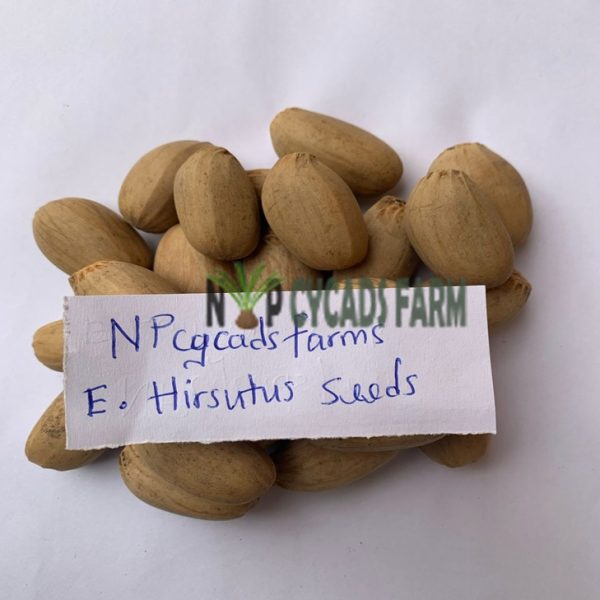Whatapp:
+278.3675.0634
Work Hours
Monday to Friday: 7AM - 7PM
Weekend: 10AM - 5PM

Original price was: $7.00.$5.00Current price is: $5.00.
Encephalartos Hirsutus Seeds are orange-red in color, measuring about 30-35 mm long and 15-18 mm in diameter.
Encephalartos hirsutus is a species of cycad that is native to Limpopo Province of South Africa. It was recorded from three separate localities on south-east-facing quartzite cliffs in the Makuya Nature Reserve bordering the Kruger National Park at elevations ranging from 800–1,000 meters (2,600–3,300 ft) above sea level.
As of 2020, it is assumed there are up to 10 individuals in the wild.
It is an arborescent cycad, with an erect stem, which becomes decumbent in older specimens, up to 4 m (13 ft) high and with a diameter of 35–40 cm (14–16 in). The leaves, pinnate, arranged in a crown at the apex of the stem, are 1.1–1.4 m (3 ft 7 in – 4 ft 7 in) long, supported by a petiole about 13 cm (5.1 in) long, and composed of numerous pairs of elliptic leaflets and coriaceous, long 13–17 cm (5.1–6.7 in), with entire margin and thorny apex, fixed on the rachis with an angle of about 40°, reduced to thorns towards the base of the petiole. It is a dioecious species, with male specimens that have from 2 to 5 cylindrical-ovoid cones, erect, about 50 cm (20 in) long and 9 cm (3.5 in) broad, and female specimens with 1–3 ovoid cones, about 40 cm (16 in) long and 35 cm (14 in) broad, of glaucous green color, glabrous. The seeds are coarsely ovoid, 3–3.5 cm (1.2–1.4 in) long, covered with an orange-red sarcotesta.
Encephalartos hirsutus is reportedly extinct in the wild, with possibly only one individual remaining in an inaccessible private reserve. This rarity makes seeds and seedlings highly valuable and difficult to obtain, often found only in elite private collections.
The species is dioecious (separate male and female plants) and is propagated primarily from seeds and suckers (offsets). Seed propagation requires patience as germination can take several months. Fresh seeds germinate best, and soaking seeds in warm water for 24 hours before sowing can improve germination rates. A well-drained seed-raising mix and consistent moisture and temperature are crucial for successful germination.
Encephalartos hirsutus grows best in full sun but tolerates light shade and is frost tolerant. It prefers well-drained soil and does not do well with excessive moisture. Artificial pollination is often necessary in cultivation to ensure seed production, involving careful timing and pollen storage at -15°C
Seedlings Development :
Seedlings should be gradually acclimated to brighter light before transplanting. Suckers can be removed and potted once they have a well-developed root system, with cut surfaces treated with fungicide to prevent infection
Toxicity :
All parts of the plant, including seeds, are toxic if ingested and have sharp features, so handling with care is advised
Encephalartos hirsutus seedlings exhibit a unique trait where the seed cracks open just before the first leaves appear, which is unusual among cycads
In summary, Encephalartos hirsutus seeds are orange-red, relatively large, and require specific conditions for germination and growth. Due to the species’ rarity and conservation status, seeds are valuable and propagation demands careful attention to environmental and pollination factors
This species has effectively been extirpated in the wild due to over-collecting for ornamental purposes.
Reviews
There are no reviews yet.